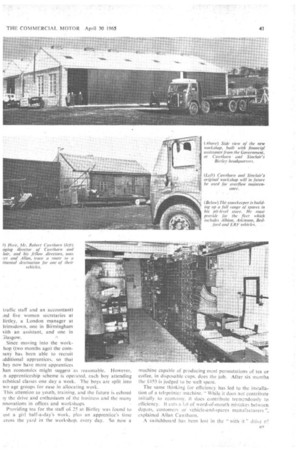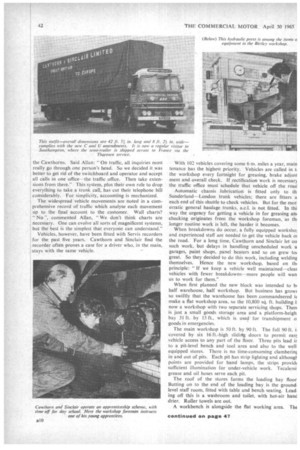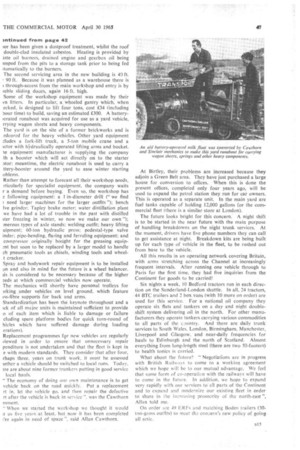RAPID EXPANSION ON ALL FRONTS
Page 42

Page 43

Page 44

Page 49

If you've noticed an error in this article please click here to report it so we can fix it.
Northern haulier's new ideas provide greater efficiency
by John Matthews THREE years ago Cawthorn and Sinclair Lid., of Durham Road, Birtley—just five miles south of Newcastle upon Tyne—had a headquarters depot extending over five acres, three outlying depots, a new brick-built office block, a father-and-son management, 40 vehicles standardized on heavy Atkinsons, five mechanics based at Birtley and some progressive ideas.
Today, they have a six-acre depot (soon to be increased to seven), four outlying depots, a new brick-built workshop constructed with financial assistance from the Government, another son in the family business, a E200,000 fleet of 102 vehicles standardizing on artics and 12 mechanics based at Birtley. And they have so many new ideas for improving their operating efficiency and for extending their key north-south services that even now they are planning to meet a need for more land and more premises.
All this should be enough to suggest that here, at least, is a success story about the haulage industry in general and the north-east in particular.
It is not insignificant to note that the most recent expansion has been State assisted. The Government aid was in the form of a grant towards the cost of the new £25,000 138 workshop block. The grant was made under the Board o Trade scheme to attract industry and employment to thosi parts officially designated depressed areas.
When application was first made 18 months ago aid vva: refused, because at that time the depot was a few hundret yards outside the boundary of the officially classifiet depressed area. Later, when Birtley was included in tht area. Cawthorn and Sinclair had not only to shov were they a sound concern and allow a Board of Tradt accountant to scrutinize their books and submit buildini plans and estimates, but also to show what benefit theii expansion would give to the area. They pointed to tilt number of fitters, drivers and apprentices who would Ix needed and the grant was agreed. Around 100 drivers and 17 fitters and apprentices are now employed.
About a yea' ago the Cawthorns 4cquired Keith Sinclair's interest in the business to make it a family concern: Robert, a haulier since 1921. managing director: sons Allan, director and general manager, and Robert, who was brought on to the board recently and is taking an increasingly active part in the management of the company.
In addition to the three directors there are five men
_Since moving into the workhop (two months ago) the corniany has been able to recruit Ldditional apprentices. .so that hey now have more apprentices hart economics might suggest as reasonable. However,' ii apprenticeship scheme is operated, each boy attending echnical classes one day a week. The boys are split into
wo age groups for ease in 'allocating work.
This attention to youth, training, and the future is echoed fy the drive and enthusiasm of the business and the many nnovationsin offices and workshops.
Providing tea for the staff of 25 at Birtley was found to ost a girl half-a-day's work, plus an apprentice's time .cross the yard in the workshop. every day. So now a
machine capable of producing most permutations of tea or coffee, in disposable cups, does the job. After six months the £459 is judged to be well spent.
The same thinkine, for efficiency has led to the installation of a teleprinter machine. " While it does not contribute initially to economy, it does contributetremendously to efficiency. It cuts a lot of word-of-mouth mistakes between depots, customers or vehicle-and-spares manufacturers explained Allan Cawthorn.
A switchboard has been lost in the "with it " drive cf the Cawthorns. Said Allan: "On traffic, all inquiries must really go through one person's head. So we decided it was better to get rid of the switchboard and operator and accept all calls in one office--the traffic office. Then take extensions from there." This system, plus their own rule to drop everything to take a trunk call, has cut their telephone bill considerably. For simplicity, accounting is mechanized.
The widespread vehicle movements are noted in a comprehensive record of traffic which analyse each movement up to the final account to the customer. Wall charts? " No ", commented Allan, "We don't think charts are necessary. One can evolve all sorts of magnificent systems, but the best is the simplest that everyone can understand."
Vehicles, however, have been fitted with Servis recorders for the past five years. Cawthorn and Sinclair find the recorder often proves a case for a driver who, in the main, stays with the same vehicle. • With 102 vehicles covering some 6 m. miles a year, main tenance has the highest priority. Vehicles are called in ti the workshop every fortnight for greasing, brake adjust ment and overall check. If rectification work is necessary the traffic office must schedule that vehicle off the road Automatic chassis lubrication is fitted only to th Sunderland—London trunk vehicles; there are fitters a each end of this shuttle to check vehicles. But for the mor erratic general haulage trunks. a.c.I. is not fitted. In thi way the urgency for getting a vehicle in for greasing a& chocking originates from the workshop foreman, •as 'hi longer routine work is left, the harder it becomes.
When breakdowns do OMB', a fully equipped worksho and experienced staff are needed to get the vehicle back cm the road. For a long time, Cawthorn and Sinclair let ou such work, but delays in handling unscheduled work a garages, paint shops, panel beaters and so on grew to great. So they decided to do this work, including welding themselves. Hence the new workshop, based on thl principle: " If we keep a vehicle well maintained—cleai vehicles with fewer breakdowns—more people will wan us to work for them."
When first planned the new block was intended to bl half warehouse, half workshop. But business has growl so swiftly that the warehouse has been commandeered t( make a flat workshop area, so the 10,800 sq. ft. building i now a workshop with two separate servicing shops. Then is just a small goods storage area and a platform-heigh bay 31 ft. by 15 ft., which is used for transhipment o goods in emergencies.
The main workshop is 50 ft. by 90 ft. The full 90 ft. covered by six 16 ft.-high sliditt doors to permit eas1 vehicle access to any part of the floor. Three pits lead ir to a pit-level bench and tool area and also to the well equipped stores. There is no time-consuming clamberini in and out of pits. Each pit has strip lighting and althougt points are provided for hand lamps, the strips provid( sufficient illumination for under-vehicle work. Tecalemi grease and oil hoses serve each pit.
The roof of the stores forms the loading bay floor Butting on to the end of the loading bay, is the ground level staff room, fitted with table and bench seating. Lead, ing off this is a washroom and toilet, with hot-air hand drier. Roller towels are out.
A workbench is alongside the flat working area. The or has been given a dustproof treatment, whilst the roof double-clad insulated asbestos. Heating is provided by Aste oil burners, drained engine and gearbox oil being imped from the pits to a storage tank prior to being fed itomatically to the burners.
The second servicing area in the new building is 49 ft. 90 ft. Because it was planned as a warehouse there is through-access from the main workshop and entry is by aible sliding doors, again 16 ft. high.
Some of the workshop equipment was made by their vn fitters. In particular, a,wheeled gantry which, when ecked, is designed to lift four tons, cost £34 (including dour time) to build, saving an estimated £300. A batterylerated runabout was acquired for use as a yard vehicle, rrying wagon sheets and heavy components.
The yard is on the site of a former brickworks and is .rdeored for the heavy vehicles. Other yard equipment :lades a fork-lift truck, a 5-ton mobile crane and a tctor with IcYdraulically operated lifting arms and bucket. ic equipment manufacturer is supplying the company th a booster which will act directly on to the starter ator; meantime, the electric runabout is used to carry a ttery-booster around the yard to ease winter starting oblerns.
Rather than attempt to forecast all their workshop needs, rticularly for specialist equipment, the company waits
✓ a .demand before buying. Even so, the workshop .has a following equipment: a 1 in-diameter drill (" we find !: need larger machines for the larger outfits "); bench lye grinder: Tapley brake meter: water distillation plant we have had a lot of trouble in the past with distilled tter freezing in winter, so now we make our own "); merous types of axle stands: welding outfit; heavy lifting uipment; 60-ton hydraulic press; pedestal-type valve inder; pipe-bending, flaring and ferruling equipment; and compressor originally bight for the greasing equip.tnt but soon to be replaced by a larger model to handle eh pneumatic tools as chisels, winding tools and wheelt cracker.
Spray and bodywork repair equipment is to be installed on and also in mind for the future is a wheel balancer. is is considered to be necessary because of the higher eeds at which commercial vehicles now operate.
The mechanics will shortly have personal trolleys for vking under vehicles on level ground, which feature iss-fibre supports for back and arms.
Standardization has been the keynote throughout and a ick of all major units is maintained sufficient to provide o of each item which is liable to damage or failure eluding spare platform bodies for quick turn-round of hicks which have suffered damage during loading erations).
Replacement programmes fvr new vehicles are regularly ✓ iewed in order to ensure that unnecessary repair penditure is not undertaken and that the fleet is kept in e with modern standards. They consider that after four, rhaps three, years on trunk work, it must be assessed tether a vehicle should be switched to local runs. Today, !.re are about nine former trunkers putting in good service local hauls.
"The economy of doing our own maintenance is to get vehicle back on the road quickly. Put a replacement rt in, let the vehicle go, and then repair the defective rt after the vehicle is back in service ". was the Cawthorn in men t.
" When we started the workshop we thought it would a us five years at least, but .now it has been completed :7re again in need of Space ". said Allan Cawthorn.
At Birtley, their problems are increased because they adjoin a Green Belt area. They have just purchased a large house for conversion to offices. When this is done the present offices, completed only four years ago, will be used to expand the petrol station they run for car owners. This is operated as a separate unit. In the main yard are fuel tanks capable of holding 12,000 gallons for the commercial fleet (there is a similar store at London).
The future looks bright for this concern. A night shift is to be started in the near future with the main purpose of handling breakdowns on the night trunk services. At the moment, drivers have five phone numbers they can call to get assistance at night. Breakdown kits are being built up for each type of vehicle in the fleet, to be rushed out from base to the vehicle.
All this results in an operating network covering Britain, with arms stretching across the Channel at increasingly frequent intervals. After running one vehicle through to Paris for the first time, they had five inquiries from the Continent for goods to be carried?
Six nights a week, 10 Bedford tractors run in each direction on the Sunderland-London shuttle. In all, 24 tractors, 44 BTC trailers and 2 box vans (with 10 more on order) are used for this service. For a national oil company they operate six flats and tankers on a day and night doubleshift system delivering oil in the north. For other manufacturers they operate tankers carrying various commodities to all parts of the c.....)untry. "And there are daily trunk services to South Wales. London, Birmingham. Manchester, Liverpool and Glasgow, and near-daily frequencies for hauls to Edinburgh and the north of Scotland. Almost everything from long-length steel (there are two 50-footers) to health tonics is carried.
What about the future? " Negotiations are in progress with British Railways to come to a working agreement which we hope will be to our mutual advantage, We feel that some form of co-operation with the railways will have to come in the future. In addition, we hope to expand very rapidly with our services to all parts of the Continent and to expand and modernize our existing fleet in order to share in the increasing prosperity of the north-east ", Allan told me.
On order are 49 ERFs and matching Boden trailers (30ton-gross outfits) to meet the concern's new policy of going all attic.




































































































